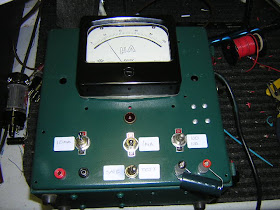


When installing a grounded three prong power cord on a Fender amplifier the question always arises "What in heck am I going to do with the courtesy outlet, which is itself ungrounded?"
It occurred to me a while ago that the courtesy outlet occupies the same footprint that a garden variety octal socket does. As I was in the process of replacing the two conductor cord on an AC568 Bassman, I also found that the power tube sockets needed replacement. It was a good opportunity to remove the hybrid cathode bias setup that Fender briefly used, and convert the bias balance to a simple bias level adjust system.
The only reason I can see that the hybrid system was used would be to ensure that if you lost your bias supply the amp wouldn't go into power tube melt down mode. It didn't last at Fender.
Checking the bias on a Bassman or similar amp configured as a head is impossible without removing the chassis, which can be problematic if changing tubes on the fly or between sets at a gig.
I took a replacement socket and installed two 1 0hm 1w 5 per cent resistors as shown. I wired each to the cathodes of the power tubes, and downstream I grounded the cathodes.
Now, setting the multimeter to millivolts will give cathode current in milliamps, and this can be read while the chassis is still installed in the head cabinet. In addition, each individual power tube cathode current can be read. Knowing the plate voltage allows the operator a safe range in which to operate, or alternatively to choose a spare set of power tubes for the road bag before leaving home.
You could bring out plate voltage to one contact but that could be a little hazardous with the number of little kids with sticky fingers that seem to always be underfoot. Better to leave it inside where it's safe.
In case you were wondering those screen resistors are Dale 2w metal film from Mouser Electronics. They meet the need and occupy a lot less real estate.














































